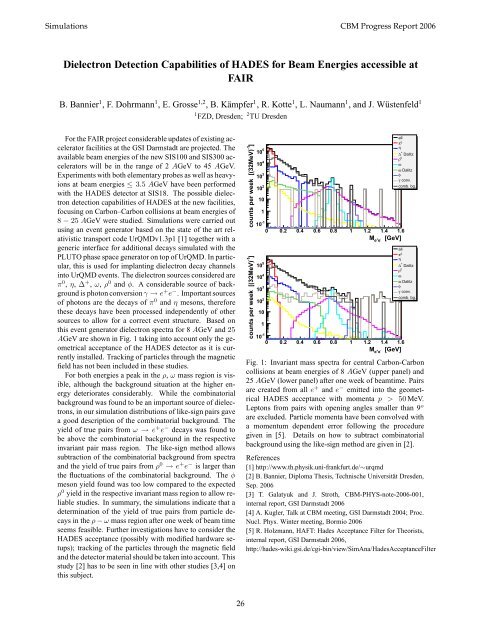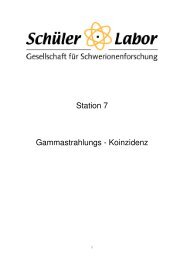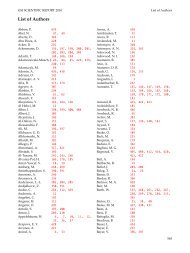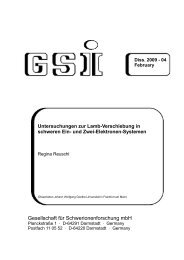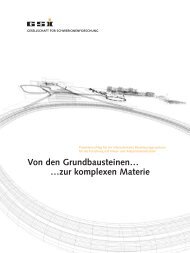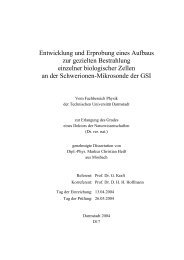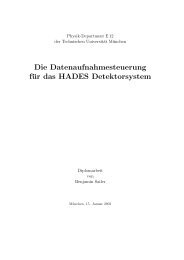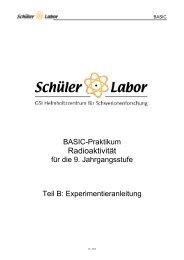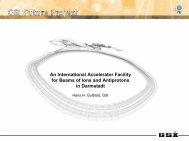CBM Progress Report 2006 - GSI
CBM Progress Report 2006 - GSI
CBM Progress Report 2006 - GSI
Create successful ePaper yourself
Turn your PDF publications into a flip-book with our unique Google optimized e-Paper software.
Simulations <strong>CBM</strong> <strong>Progress</strong> <strong>Report</strong> <strong>2006</strong><br />
Dielectron Detection Capabilities of HADES for Beam Energies accessible at<br />
FAIR<br />
B. Bannier 1 , F. Dohrmann 1 , E. Grosse 1,2 , B. Kämpfer 1 , R. Kotte 1 , L. Naumann 1 , and J. Wüstenfeld 1<br />
For the FAIR project considerable updates of existing accelerator<br />
facilities at the <strong>GSI</strong> Darmstadt are projected. The<br />
available beam energies of the new SIS100 and SIS300 accelerators<br />
will be in the range of 2 AGeV to 45 AGeV.<br />
Experiments with both elementary probes as well as heavyions<br />
at beam energies ≤ 3.5 AGeV have been performed<br />
with the HADES detector at SIS18. The possible dielectron<br />
detection capabilities of HADES at the new facilities,<br />
focusing on Carbon–Carbon collisions at beam energies of<br />
8 − 25 AGeV were studied. Simulations were carried out<br />
using an event generator based on the state of the art relativistic<br />
transport code UrQMDv1.3p1 [1] together with a<br />
generic interface for additional decays simulated with the<br />
PLUTO phase space generator on top of UrQMD. In particular,<br />
this is used for implanting dielectron decay channels<br />
into UrQMD events. The dielectron sources considered are<br />
π 0 , η, ∆ + , ω, ρ 0 and φ. A considerable source of background<br />
is photon conversionγ → e + e − . Important sources<br />
of photons are the decays of π 0 and η mesons, therefore<br />
these decays have been processed independently of other<br />
sources to allow for a correct event structure. Based on<br />
this event generator dielectron spectra for 8 AGeV and 25<br />
AGeV are shown in Fig. 1 taking into account only the geometrical<br />
acceptance of the HADES detector as it is currently<br />
installed. Tracking of particles through the magnetic<br />
field has not been included in these studies.<br />
For both energies a peak in the ρ, ω mass region is visible,<br />
although the background situation at the higher energy<br />
deteriorates considerably. While the combinatorial<br />
background was found to be an important source of dielectrons,<br />
in our simulation distributions of like-sign pairs gave<br />
a good description of the combinatorial background. The<br />
yield of true pairs from ω → e + e − decays was found to<br />
be above the combinatorial background in the respective<br />
invariant pair mass region. The like-sign method allows<br />
subtraction of the combinatorial background from spectra<br />
and the yield of true pairs from ρ 0 → e + e − is larger than<br />
the fluctuations of the combinatorial background. The φ<br />
meson yield found was too low compared to the expected<br />
ρ 0 yield in the respective invariant mass region to allow reliable<br />
studies. In summary, the simulations indicate that a<br />
determination of the yield of true pairs from particle decays<br />
in the ρ − ω mass region after one week of beam time<br />
seems feasible. Further investigations have to consider the<br />
HADES acceptance (possibly with modified hardware setups);<br />
tracking of the particles through the magnetic field<br />
and the detector material should be taken into account. This<br />
study [2] has to be seen in line with other studies [3,4] on<br />
this subject.<br />
1 FZD, Dresden; 2 TU Dresden<br />
26<br />
]<br />
-1<br />
counts per week [(32MeV)<br />
]<br />
-1<br />
counts per week [(32MeV)<br />
5<br />
10<br />
4<br />
10<br />
3<br />
10<br />
2<br />
10<br />
10<br />
1<br />
-1<br />
10<br />
0 0.2 0.4 0.6 0.8 1 1.2 1.4 1.6<br />
M + - [GeV]<br />
5<br />
10<br />
4<br />
10<br />
3<br />
10<br />
2<br />
10<br />
10<br />
1<br />
-1<br />
e e<br />
all<br />
π0<br />
η<br />
+<br />
Δ Dalitz<br />
0<br />
ρ<br />
ω<br />
ω Dalitz<br />
φ<br />
γ conv.<br />
10<br />
0 0.2 0.4 0.6 0.8 1 1.2 1.4 1.6<br />
M + - [GeV]<br />
e e<br />
comb. bg.<br />
all<br />
π0<br />
η<br />
+<br />
Δ Dalitz<br />
0<br />
ρ<br />
ω<br />
ω Dalitz<br />
φ<br />
γ conv.<br />
comb. bg.<br />
Fig. 1: Invariant mass spectra for central Carbon-Carbon<br />
collisions at beam energies of 8 AGeV (upper panel) and<br />
25 AGeV (lower panel) after one week of beamtime. Pairs<br />
are created from all e + and e − emitted into the geometrical<br />
HADES acceptance with momenta p > 50 MeV.<br />
Leptons from pairs with opening angles smaller than 9 o<br />
are excluded. Particle momenta have been convolved with<br />
a momentum dependent error following the procedure<br />
given in [5]. Details on how to subtract combinatorial<br />
background using the like-sign method are given in [2].<br />
References<br />
[1] http://www.th.physik.uni-frankfurt.de/∼urqmd<br />
[2] B. Bannier, Diploma Thesis, Technische Universität Dresden,<br />
Sep. <strong>2006</strong><br />
[3] T. Galatyuk and J. Stroth, <strong>CBM</strong>-PHYS-note-<strong>2006</strong>-001,<br />
internal report, <strong>GSI</strong> Darmstadt <strong>2006</strong><br />
[4] A. Kugler, Talk at <strong>CBM</strong> meeting, <strong>GSI</strong> Darmstadt 2004; Proc.<br />
Nucl. Phys. Winter meeting, Bormio <strong>2006</strong><br />
[5] R. Holzmann, HAFT: Hades Acceptance Filter for Theorists,<br />
internal report, <strong>GSI</strong> Darmstadt <strong>2006</strong>,<br />
http://hades-wiki.gsi.de/cgi-bin/view/SimAna/HadesAcceptanceFilter


